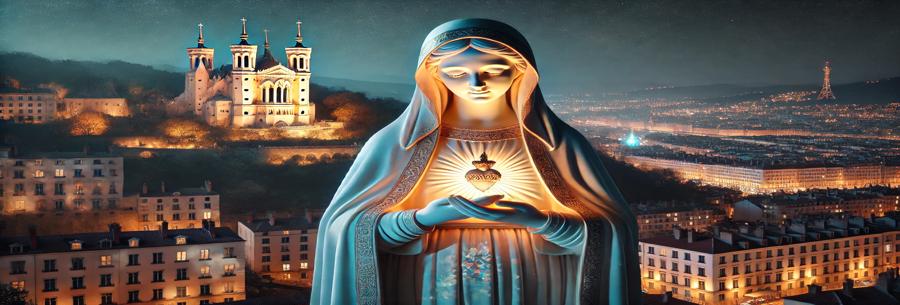The role of the statue of the Virgin Mary on Fourvière hill in Lyon's festival
The statue of the Virgin Mary, perched atop Fourvière hill in Lyon, is much more than an emblematic monument. She is the spiritual and historic heart of the Festival of Lights, a symbol of protection, gratitude and unity for the people of Lyon. Since its inauguration in 1852, the statue has played a central role in the celebrations of 8 December, combining religious faith with popular traditions. This article explores the history, significance and impact of this statue as part of Lyon's famous celebration.
A statue born of a historic vow
The aldermen's vow in 1643:
The history of Lyon's Marian devotion dates back to 1643, when a plague epidemic was threatening the city. Lyon's aldermen made a vow to go up Fourvière Hill in procession every year to ask for the Virgin Mary's protection. This vow marked the beginning of a special relationship between the city and the hill.
The decision to erect a statue:
In the 19th century, the Lyonnais' attachment to the Virgin Mary grew stronger, particularly under the impetus of Cardinal de Bonald. To honour this bond, it was decided to erect a monumental statue of the Virgin on the chapel of Fourvière.
The inauguration of the statue in 1852
A postponed inauguration:
Initially scheduled for 8 September 1852, the day of the Nativity of the Virgin, the inauguration was postponed to 8 December due to major flooding on the Saône. This change of date gave birth to a tradition.
A spontaneous celebration:
On the evening of 8 December 1852, despite the uncertain weather, local residents spontaneously lit their windows with candles to celebrate the installation of the statue. This gesture marked the birth of the luminous tradition that would become the Festival of Lights.
The characteristics of the statue:
Size and composition:
The statue, over 5 metres high, is made of gilded bronze.
Representation:
It shows the Virgin Mary standing, carrying the Infant Jesus in her arms, a symbol of protection and blessing.
Position:Placed at the top of the basilica's bell tower, it dominates the city and watches over its inhabitants.
The statue's spiritual role in Lyon's festivities
A symbol of protection:
For the people of Lyon, the statue is a tangible sign of the Virgin Mary's protection. In times of crisis, such as epidemics or wars, the inhabitants turn to her with faith and hope.
A place of pilgrimage:
Every 8 December, the faithful go up to the Fourvière basilica to pray and take part in masses in honour of the Virgin. The statue becomes a spiritual focal point.
A source of inspiration for the light:
The light, omnipresent in the Lyon festival, has its origins in the spiritual radiance of the Virgin. The statue is often illuminated to recall this link between faith and clarity.
The statue and the evolution of the Fête des Lumières
Integration into modern installations:
With the artistic development of the Fête des Lumières, the statue remains a central element. It is often highlighted by light projections or innovative scenography.
An anchor between tradition and modernity:
As the Festival of Lights opens up to international artistic creations, the statue of the Virgin is a reminder of the event's religious and historical roots.
A cultural and heritage symbol
A Lyon icon: the statue of the Virgin of Fourvière is a visual and cultural landmark. It embodies Lyon's identity and is immediately recognisable.
A tourist attraction: many visitors come to Lyon to admire the Basilica of Fourvière and its statue, attracted by the panoramic view over the city and the site's rich history.
The challenges of conservation and modernisation
Maintenance of a historic monument:
The statue, exposed to the elements, requires regular maintenance to preserve its brilliance. Restorations take place periodically to ensure its longevity.
Integration of new technologies:
With the development of the Festival of Lights, efforts are being made to integrate the statue into light shows while respecting its sacred character.
The statue of the Virgin Mary on Fourvière hill is much more than just a religious sculpture or an architectural landmark. She embodies the soul of Lyon, uniting the people around a shared history of faith, gratitude and celebration. A symbol of divine protection since the 17th century, it bears witness to centuries of Marian devotion, crises overcome thanks to faith, and the gratitude of the people of Lyon to their heavenly protector.
Every 8 December, the statue becomes the focal point of a festival where spirituality meets modernity. Towering over the city, it reminds everyone of the sacred origins of the Festival of Lights, which, despite its evolution into a cultural and artistic event, retains a deep connection with the religious traditions that gave birth to it. The modern light projections and artistic installations that surround it enrich this festival while highlighting its sacred and timeless character.
In addition, the statue embodies the spirit of unity and community. Successive generations of Lyonnais and visitors gather around this monument, to remember, pray, celebrate and admire. It is also a testament to the resilience and adaptability of traditions, which continue to flourish and adapt to contemporary realities without denying their roots.
Today, the statue of the Virgin of Fourvière is not just a religious icon or a heritage site: it is Lyon's beacon of light, a source of inspiration for its residents and a universal message of hope and light for all those who come to admire its radiance. Through its central role in the Festival of Lights, it is a magnificent illustration of how a local tradition can transcend borders and eras to become a universally loved event.




















